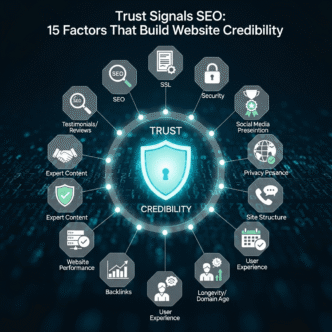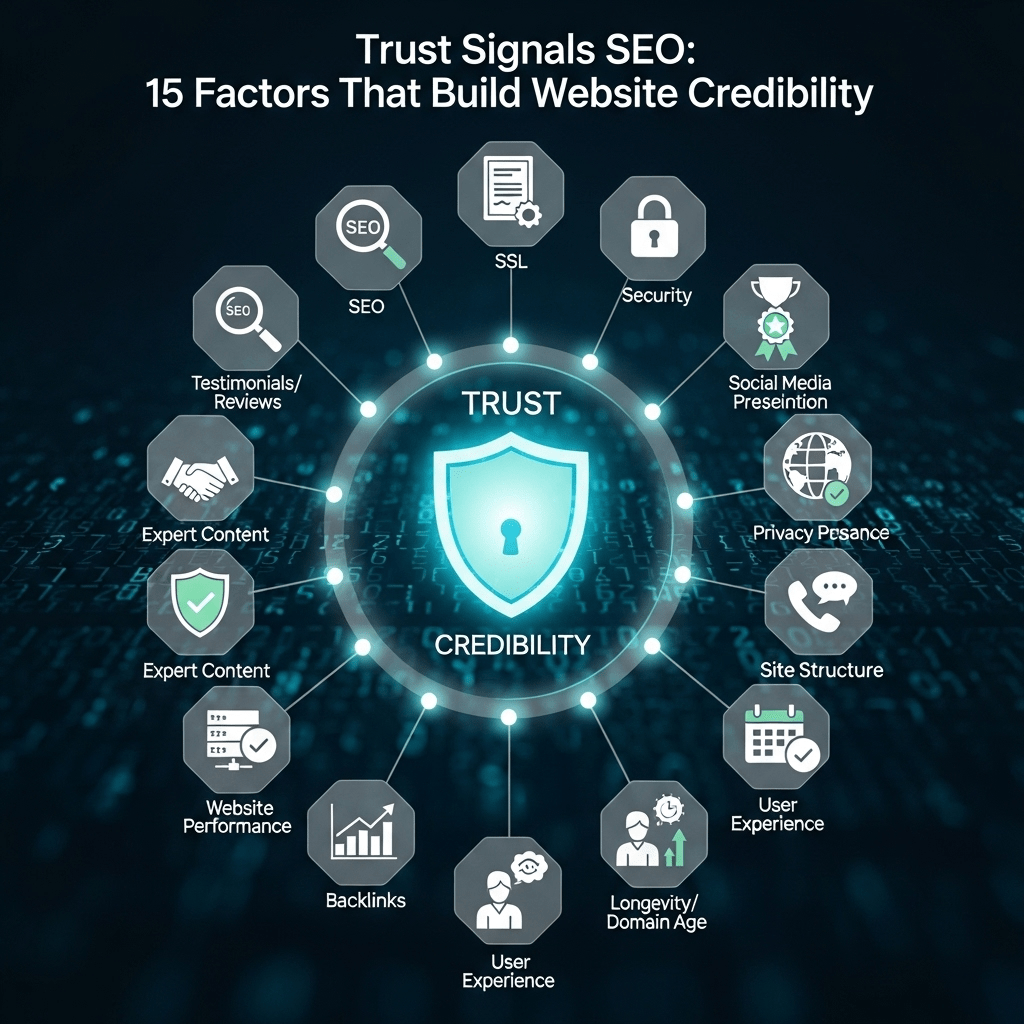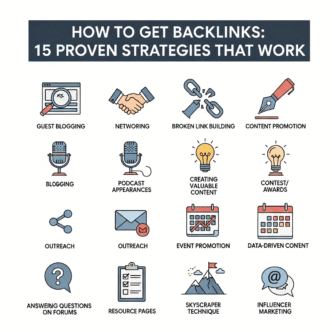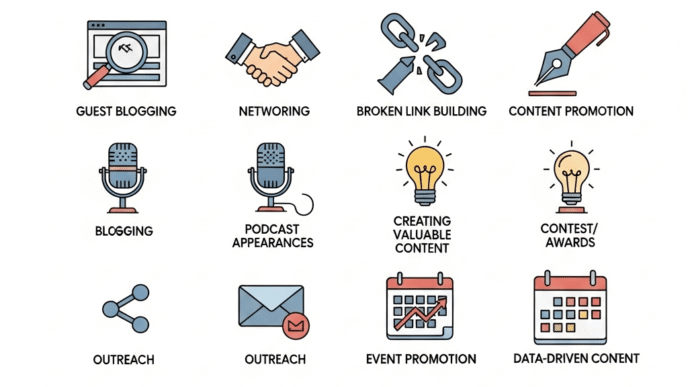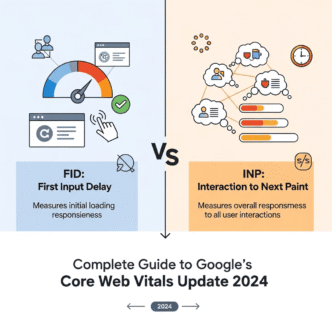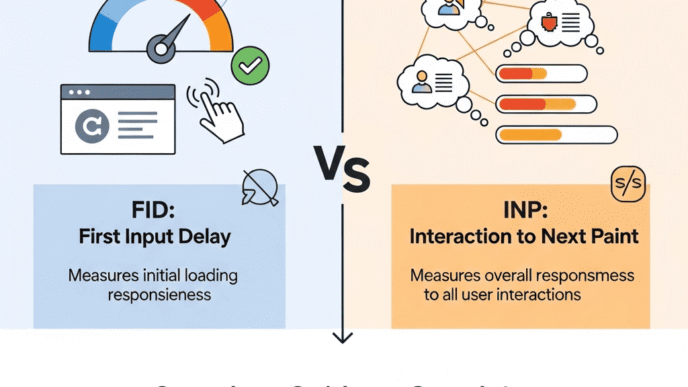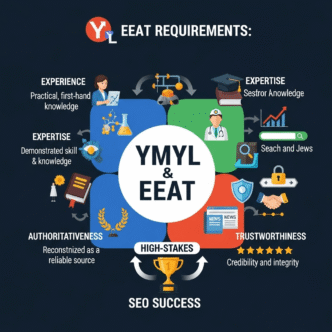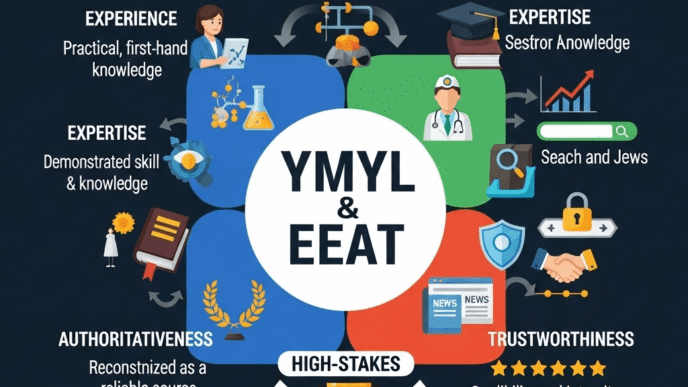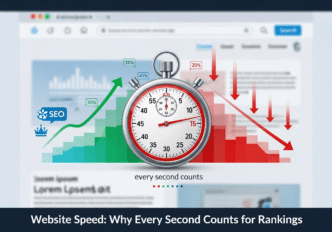Ever wondered why some websites instantly feel trustworthy while others make you want to hit the back button faster than a sketchy email from a “Nigerian prince”? The difference often comes down to something most website owners completely ignore: trust signals SEO.
If your beautifully designed website is struggling to convert visitors or rank well despite great content, you might be missing the invisible credibility factors that Google and users desperately want to see. Trust signals SEO isn’t just about looking professional – it’s about proving to both search engines and humans that your website deserves their confidence.
Here’s the uncomfortable truth: You could have the world’s best content, but if visitors don’t trust your site within the first 3 seconds, they’re gone. And if Google doesn’t trust your site, you’ll never see page one.
Understanding how these signals integrate with Google’s comprehensive trust and authority framework becomes your competitive advantage.
Table of Contents
Toggle
What Are Trust Signals SEO and Why They’re Your Website’s Lifeline
Trust signals SEO refers to the visible and technical elements on your website that communicate credibility, safety, and reliability to both search engines and users, directly impacting rankings and user behavior.
Think of trust signals SEO as your website’s reputation system. Just like you’d hesitate to buy from a store with broken windows and no visible business license, online visitors make instant judgments about your website’s trustworthiness based on specific signals.
The statistics are staggering: 94% of users cite web design as the reason they mistrust or reject a website. Meanwhile, websites with strong trust signals see 42% higher conversion rates and significantly better search engine performance.
Pro Tip: “Trust signals work because they reduce perceived risk for users. When people feel safe on your website, they stay longer, engage more, and convert at higher rates – all signals that Google uses to determine content quality and user satisfaction.”
Website Credibility Factors That Actually Move the Needle
Understanding the most impactful website credibility factors helps prioritize your trust-building efforts for maximum SEO and conversion impact.
The Trust Signal Hierarchy
Tier 1: Security and Safety Signals
- SSL certificates and HTTPS implementation
- Secure payment processing indicators
- Privacy policy and data protection information
- Contact information and physical address
Tier 2: Professional Credibility Signals
- Professional website design and user experience
- About page with team information and credentials
- Customer testimonials and reviews
- Professional certifications and awards
Tier 3: Social Proof and Authority Signals
- Media mentions and press coverage
- Social media presence and engagement
- Industry partnerships and associations
- Client logos and case studies
Trust Signal Impact Analysis
| Trust Signal Category | Implementation | User Impact | SEO Impact | Priority |
|---|---|---|---|---|
| SSL Certificate | Very Easy | High | High | Immediate |
| Contact Information | Easy | High | Medium | Week 1 |
| Customer Reviews | Medium | Very High | High | Month 1 |
| Professional Design | Medium | Very High | Medium | Month 1 |
| About Page | Easy | Medium | Medium | Week 2 |
| Privacy Policy | Easy | Medium | Low | Week 2 |
The 15 Essential Site Trust Indicators
These site trust indicators represent the most crucial elements for building comprehensive website credibility.
1-5: Foundation Trust Signals
1. SSL Certificate and HTTPS: The padlock icon that shows data encryption and security.
2. Complete Contact Information: Physical address, phone number, email, and business hours prominently displayed.
3. Professional About Page: Team member bios with photos, company story, and credentials.
4. Customer Reviews and Testimonials: Real feedback from actual customers with photos when possible.
5. Privacy Policy and Terms: Legal compliance and transparency about data usage.
6-10: Credibility Enhancers
6. Professional Website Design: Clean layout, consistent branding, and mobile responsiveness.
7. Security Badges: McAfee Secure, Norton, or payment processor security indicators.
8. Social Media Presence: Active, professional profiles linked from your website.
9. Physical Address Verification: Google My Business listing and local presence indicators.
10. Return/Refund Policies: Clear, fair policies that reduce purchase anxiety.
11-15: Authority Builders
11. Professional Email Addresses: Branded emails (@yourcompany.com) instead of Gmail.
12. Awards and Recognition: Industry awards, certifications, and media mentions.
13. Client Logos and Case Studies: Success stories and recognizable client names.
14. Content Freshness: Recent publication dates and regularly updated information.
15. Error-Free Experience: No broken links, correct spelling, and functional features.
Understanding how these factors align with Google’s broader trust evaluation criteria ensures comprehensive credibility building.
How to Build Website Trust Factors That Matter Most
Website trust factors that matter most have evolved as Google’s algorithms become more sophisticated and user expectations increase.
Priority Implementation Strategy
Phase 1 (Week 1): Security Foundation
- Install SSL certificate and enable HTTPS
- Add comprehensive contact information
- Create privacy policy and terms of service
- Fix any broken links or technical errors
Phase 2 (Week 2-4): Credibility Building
- Develop professional About page with team photos
- Collect and display customer testimonials
- Add security badges and certifications
- Ensure mobile-responsive design
Phase 3 (Month 2+): Authority Enhancement
- Build social media presence and engagement
- Seek industry recognition and awards
- Create case studies and success stories
- Maintain regular content updates
Real-World Success: Shopify’s Trust Strategy
Shopify demonstrates excellent online trust building through:
- Security Focus: Prominent security certifications and compliance information
- Social Proof: Customer success stories and recognizable brand logos
- Transparency: Clear pricing, terms, and company information
- Professional Design: Clean, consistent interface across all platforms
Results: High user trust translates to better conversion rates and strong search rankings.
Trust Signal Optimization Strategies for Better SEO
Effective trust signal optimization strategies require systematic implementation and ongoing maintenance.
Technical Trust Implementation
Security Setup:
- SSL certificate installation and HTTPS redirects
- Security header implementation
- Regular security scanning and monitoring
- Malware protection and cleanup procedures
Schema Markup for Trust:
{
"@context": "https://schema.org",
"@type": "Organization",
"name": "Your Company",
"address": {
"@type": "PostalAddress",
"streetAddress": "123 Business St",
"addressLocality": "City"
},
"telephone": "+1-555-123-4567"
}
Content Trust Factors
Author Information: Clear attribution with credentials and contact details.
Source Citation: Proper references to authoritative sources for all claims.
Transparency: Clear disclosure of relationships, sponsorships, or conflicts of interest.
Currency: Regular content updates with visible publication dates.
For comprehensive guidance on implementing these within a complete SEO strategy, explore our detailed trust and authority building framework.
Common Trust Signal Mistakes That Kill Credibility
Understanding common mistakes helps avoid credibility damage that can take months to repair.
The “Generic Business” Trap
Mistake: Using stock photos and template designs without customization. Solution: Use authentic photos and original content that reflects your actual business.
The “Information Vacuum” Problem
Mistake: Providing minimal contact information or hiding behind generic emails. Solution: Include comprehensive contact details with individual team member information.
The “Security Negligence” Disaster
Mistake: Ignoring SSL certificates or basic website security measures. Solution: Prioritize security and display certifications prominently.
Pro Tip: “The biggest trust signal mistake is thinking you can fake credibility. Users and search engines are sophisticated at detecting authentic versus manufactured trust signals. Focus on building genuine credibility rather than just appearing credible.”
Measuring Your Trust Signals SEO Success
Track the effectiveness of your trust signal efforts through key performance indicators.
Primary Success Metrics
User Behavior Improvements:
- Reduced bounce rate after trust signal implementation
- Increased time on site and pages per session
- Higher conversion rates from visitors to customers
- More return visitors and direct traffic
Search Performance Gains:
- Improved keyword rankings for target terms
- Increased organic traffic to key pages
- Higher click-through rates from search results
- More featured snippet and knowledge panel appearances
Business Impact Indicators:
- Increased lead generation and customer inquiries
- Higher customer lifetime value
- More positive reviews and testimonials
- Improved brand search volume
Your Trust Signals SEO Action Plan
Ready to build unshakeable website credibility? Here’s your step-by-step implementation guide.
Week 1-2: Foundation Building
Immediate Actions:
- [ ] Install SSL certificate and implement HTTPS sitewide
- [ ] Add comprehensive contact page with all business information
- [ ] Create professional About page with team photos and credentials
- [ ] Implement privacy policy and terms of service
- [ ] Test all website functionality for errors
Month 1: Credibility Enhancement
Trust Building:
- [ ] Collect and display customer testimonials with photos
- [ ] Add security badges and professional certifications
- [ ] Optimize social media profiles and link them prominently
- [ ] Ensure mobile-responsive, professional design
- [ ] Implement review collection system
Month 2+: Authority Building
Long-term Strategy:
- [ ] Seek industry awards and recognition opportunities
- [ ] Create detailed case studies with client permission
- [ ] Build thought leadership through expert content
- [ ] Monitor and maintain all trust signals regularly
Understanding how this implementation fits within Google’s complete authority framework ensures maximum SEO impact.
Final Verdict: Trust Signals as Your Competitive Advantage
Mastering trust signals SEO creates lasting competitive advantages in both search rankings and business success.
The Trust Signal Reality
The Stakes: In an online world filled with scams and misleading information, trust has become the ultimate currency.
The Opportunity: Most websites implement trust signals poorly, creating opportunities for those who get it right.
The Impact: Strong trust signals create compounding benefits – better user experience leads to better rankings, more traffic, and higher conversions.
Your Success Formula
Security + Transparency + Social Proof + Professional Presentation = Unshakeable Website Credibility
The websites that dominate in 2025 won’t just have good content – they’ll have comprehensive trust signal implementation that makes users feel safe and confident.
Start building your trust signal foundation today. Your rankings, conversions, and business reputation depend on it.
This guide on trust signals SEO provides essential strategies for building website credibility and search engine trust in 2025.

